| |
|||||
|---|---|---|---|---|---|
| Eurasian Federation | |||||
| |||||
| Motto "Ut unurn sint" |
|||||
| National Anthem Hymn for Unity | |||||
| Capital | Black Pearl City | ||||
| Largest City | Baku | ||||
| Official Languages | English, Georgian, Ukrainian, Azerbaijani, Armenian, Russian | ||||
| Demonym | Evraziis, Eurasian | ||||
| Government | Constitutional Nation-state Federation | ||||
| - Chairman of the Federation |
Reyneir ze Gallis |
||||
| - President of the Council |
Yuri Tokarev |
||||
| - Speaker of the House of Representatives |
Cagalli Sonnata |
||||
| Legislature | House of Representatives | ||||
| Supreme Court | Supreme Council | ||||
| Major Religions | Orthodox Christianity, Islam | ||||
| National Animal | Lion, Horse | ||||
| Formation - Black Sea War - Great Restoration |
19 September 1994 16 April 1997 |
||||
| Total Area | 220,143 km2 | ||||
| Total Population - Main Ethnicity |
19,582,665 (2011) Caucasians |
||||
| Currency | Eurasian mark (ℳ) (EM) |
||||
| Nominal GDP - Total - Per Capita |
2011 estimate |
||||
| Literacy Rate | 72.4% | ||||
| Internet TLD | .ef | ||||
| Driving Lane | Right | ||||
| Date Format | dd/mm/yyyy | ||||
| Time Zone | UTC+4:00 | ||||
The Eurasian Federation, also officially called as the Alliance of United Eurasia (AUE) or simply Eurasia, was once a military alliance that eventually formed into one united sovereignty. It is a country of nation-states in the Caucasus region that mostly dominates the Black sea. It is composed of the three founding members of Georgia, Armenia, and Azerbaijan and is now joined by the addition of the nation-states of Crimea, Ossetia, and Chechnya while Ingushetia and several Black sea islands are being occupied. Following the events after a grueling campaign against terrorists and anti-AUE factions, Abkhazia and Nagorno-Karabakh have been considered as nation-states as well and was admitted into the Eurasian Federation effectively bringing peace and stability within the country. Black Pearl is recognized as a nation-state as well under the central government following a resolution passed by the Eurasian Federation. Nakhchivan and Ingushetia, former territories of the Federation under the Special Administrative Zone, are now nation-states as well.
The AUE is bordered by Russia to the north, Ukraine to the northwest, Bulgaria to the west, Turkey to the southwest, and Iran to the southeast. Also, the Eurasian Federation has access to the Caspian sea to the east and to the Black sea, which is considered as a key strategic national territory, to the west. Due to past events, the AUE has sour relations with its neighbors, and other countries sharing the Black sea, notably with Russia, Bulgaria, Iran and also including Greece, Iraq and Syria due to their roles in the Black Sea War. Excluding these issues, the AUE is considered as a neutral country and its government is currently busy prioritizing war reparations and economic growth. Some countries though, especially its neighboring countries, have criticized the "excessive" build-up and strengthening of the AUE's military forces especially in the Black sea, where the Eurasian Federation is focusing to project its influence, power and military presence.
The Eurasian Federation is in good terms with several members of the European Union and the Association of Southeast Asian Nations, and is considered as a staunch military and political ally of India, Argentina and South Africa. It is also a member of the United Nations, Commonwealth of Independent States, Black Sea Treaty Organization, International Monetary Fund, Eurasian Economic Community and World Trade Organization. The Eurasian Federation is also enjoying its partnership with NATO and its observer status in the Shanghai Cooperation Organisation. Due to its conflict with Russia, the AUE declined to join the Eurasian Union and withdrew from the Collective Security Treaty Organization although it does have good relations with the other member-countries in the union with the exception of Moscow. The AUE is currently applying to join the Organization for Democracy and Economic Development. The Eurasian Federation is currently proposing a new bloc of former Soviet Union states which excludes Russia and Belarus.
Strictly speaking, the name "Eurasian Federation" is used to refer to the central federal government while the "Alliance of United Eurasia" or AUE is used to refer to all of the nation-states and to the country as a whole. Interestingly, the Eurasian Federation/AUE is treated as both a single sovereign nation and as a confederate-like alliance.
History[]
- Main article: History of the Eurasian Federation
Formation[]

The Black Pearl (6 hours after explosion) still submerged under water although steadily drying up.
In the night of 9 June 1994, Turkey conducted a clandestine deep underwater nuclear test in the Black sea under its strategic nuclear arms program. However a problem occurred with the weapons system and the nuclear warhead exploded before even reaching 200ft. The succeeding events were beyond everyone's expectations and even what could scientists calculate and estimate. A large hole, named the "Black Pearl" by the media, was left on the site of the explosion due to the underestimated yield of the nuclear explosion.
"We were only evaluating what we expected to be a nuclear explosion with a yield of less than 10 kilotons to be used for economic practices only and not for it to be developed into a weapon."—TAF spokesperson
But the hole was not just the damage done by the explosion. It also caused a great acceleration of net outflow of the Black Sea which gave it a severe negative water balance, gushing out the sea's waters to the Aegean sea. With the danger that it could receive the same fate as the Aral sea, the Turkish government with the help of numerous international organizations and governments, spearheaded an effective plan to prevent the water from leaving and to save the dying sea. Within three months a grand dam was built in the Dardanelles and Bosphorus and tons of aquatic animals and plants were transferred to other compatible habitats.
Still though, it left the Black sea and the countries surrounding it with severe environmental and economic problems. Shipping and fishing businesses, ports, shipyards and docks, and fish plants around it were forced to shut down due to the severely decreased water levels of the sea. Another strange environment damage of the nuclear explosion is that it left the area around the hole hydrophobic. The ground itself is rejecting contact with the water around it creating a large dry patch of land in the middle of the dying sea which was named by the media as the "Land of the Black Pearl".
The incident also left a political crisis. International and internal pressure was mounting on the Turkish government as it is being criticized world-wide for the incident. An international investigation was launched alongside a separate Turkish one. Rumors and conspiracy theories about the event were viral in the internet which included a plausible scenario.
"It is possible that an unknown entity sabotaged the totally planned and coordinated nuclear test during that fateful night and it is being considered by the investigators. We would not like to point our fingers until the investigations have been thoroughly reviewed."
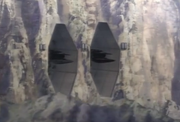
Poseidon's Base, the secret Greek military installation with two submarines in its underwater docks
Also, the incident revealed a secret underwater military installation within Bulgarian littoral zone that is being operated by Greece with two new submarines stationed in it. Bulgaria quickly denied allegations that it was having a secret deal with Greece to jointly control the Black sea and to annex Crimea, Georgia, the Gallipoli peninsula, and the Russian districts of Southern Federal District and North Caucasian Federal District. This revelation raised suspicions for Greek interests in the area, along with the other Black sea countries' roles in the incident, and the crisis is rapidly turning into a military conflict.
By 11 September 1994, only two days after the dam that saved the remaining waters of the Black sea was built, the Black Sea Fleet and the Russian military was mobilized with authorization from the Kremlin for the sake of its national security. This was highly criticized by the other countries of the Black Sea, the United Nations, and by NATO.
"We condemn the latest decision of Russia to deploy its military assets in the Black Sea and the Caucasus. This is an act of aggression which could be retaliated back with force and is heightening the already tensed situation in the said region. Stability and peace would not bear fruit unless Russia withdraws its armed forces."—NATO spokesperson

The original AUE flag

Georgian, Armenian, and Azerbaijani heads of state shook hands in the official declaration of existence of the AUE
By 12 September, it was pandemonium in the diplomatic community. Bulgaria, Georgia, Romania, Russia, Turkey, Ukraine, and Greece all scrambled to get international support, political and military allies, and to mobilize and get their respective countries ready for war. Georgia was able to gain the support of Armenia and Azerbaijan, forming the military bloc Alliance of United Eurasia and officially announcing its existence on 13 September. NATO, which had an obligation to its two opposing members (Turkey and Greece), decided to remain neutral; threatening to suspend or even expel the two countries (or just one of them) in the advent of war between the two. The other countries also requested support from NATO especially Ukraine, who has a partnership with it.

AUE soldiers in a trench on the Turkish front. (circa 23 November 1995)
The United Nations Security Council decided to hold a dialogue with the Black sea countries and Greece to ease military tensions and armed presence in the region on 18 September. But the dialogue failed to solve the issue since each country would not back down in asserting its own claims and conditions for the rest. By 19 September 1994, the hostilities concluded to declarations of war from each respective country officially starting the Black Sea War which would eventually end through mutual agreement by 16 April 1997.
This mutual agreement to restore peace, stability and progress in the region, with the included article that each combatant involved is responsible to war reparations by fixing the dying Black sea, led to the Great Restoration; it was also after the war that the AUE declared that it will now be an official sovereign country. Although the treaty, which also formed the Black Sea Treaty Organization, was followed by the Black sea states and Greece, animosity between them still exists. During the war, Romania briefly joined the AUE but left soon after the war while Turkey also aligned itself with the AUE-led coalition albeit it was met with much resent and criticism.
Post-formation[]

Black Pearl City being constructed
The Eurasian Federation was able to make quick progress following the war and has since established itself as a major player in the region. After the Black Sea War, Crimea, Ossetia and Chechnya became a member of the Alliance of United Eurasia as fellow nation-states. The AUE was able to gain the Russian federal subject Ingushetia (considered a part of Chechnya but administered by the central government), the Greek military base within Bulgarian littoral zone, the Poseidon's Base, and was also given the "Land of the Black Pearl" under a provision in the treaty. The AUE has also occupied several islands in the Black sea after the war. The central government itself is administering Black Pearl City and has turned it into the capital of AUE for political reasons (to avoid favoritism to any nation-state). With huge funds dedicated in developing Black Pearl and the area around it, the city is now considered a growing metropolis and is regarded as a triumph in solving a dire environmental-economic problem. Black Pearl City is acting as the hub for socio-economic growth as well as the center of political and military power.
Two years after the war, on 19 September 1999, while the country is celebrating and honoring the past that formed the country, simultaneous terrorist attacks on each nation-state including Black Pearl, killed 139 civilians, 5 local government officials, and 27 security personnel while injuring hundreds of innocent bystanders. A joint statement made by the Nagorno-Karabakh Republic and the Republic of Abkhazia (Apsny) soon claimed responsibility for the attacks which involved IED explosions, bombings and direct action. This started the first day of the Eurasian 100 Days of Blood, a grueling campaign launched by the central AUE government in retaliation.
"We would like to announce that the special forces division of the joint military command of the republics of Nagorno-Karabakh and Abkhazia have just conducted a successful operation against the Alliance of United Eurasia. We would like to make a declaration of war to the Eurasian Federation who have unlawfully annexed us forcefully and without due process and negotiations. For the sake of liberating our lands, Nagorno-Karabakh and Abkhazia have joined forces to bring down this invader in an epic David-versus-Goliath battle. We would not lay down our weapons until the AUE have withdrawn itself from both countries as we rightfully claim it as ours. May the heavens above smile upon us!"—Quote from the joint statement uploaded through the internet

AUE soldiers conducting a search and destroy operation in Nagorno-Karabakh
There was immediately a media frenzy regarding the announcement and the attacks. Moreover, two hours after the statement was uploaded online through the internet, reports coming from AUE outposts in Nagorno-Karabakh and Abkhazia flooded the central government's military command claiming that they were overrun by hostile unknown forces which effectively meant that AUE lost control of the areas. The Eurasian Federation quickly identified the two as insurgents and acknowledge the declaration of hostilities made by deploying its armed forces "to regain control over the areas attacked". Security forces during the attacks were able to pursue and arrest two suspects involved while the others were killed or ultimately fought back. The insurgents were popularly called as "Zero Angel" by the media, after its AUE IFF military code name, NGL 00 (Non-Governmental Liaison).
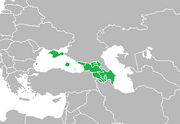
The Eurasian Federation and its member-states
Unfortunately, the Chechen Republic of Ichkeria also joined the fray by supporting the rebelling Nagorno-Karabakh and Abkhazia. Ichkeria was disappointed and dissatisfied with its political status after the Black Sea War; believing that they will be recognized as an independent sovereign country after, they joined the AUE not knowing that Chechnya will be incorporated as a nation-state of the Eurasian Federation. Anti-AUE sentiments grew accusing the Eurasian Federation as "traitors" and "backstabbers", although there is a huge percentage of people in Chechnya, who call themselves "Chechnyans" and not "Ichkerians" and already satisfied with their home country being a nation-state of the AUE instead of having an actual independence.
The Eurasian Federal eventually gained control over Nagorno-Karabakh and Abkhazia on 28 December 1999, approximately 99 days after the initial terrorist attack that sparked the separatist war. The masterminds and collaborators for the deadly killings and the war that followed were arrested and were given the death sentence. On the same day, Nagorno-Karabakh and Abkhazia were reintroduced to the AUE as separate nation-states. On the other hand, Ichkeria did not surrendered even though it lost all of its major territories and its government went into exile. Insurgency is still a problem in Chechnya although there was a ceasefire agreed and signed by representatives from both parties. The JMC-AUE is still maintaining a blockade of Ichkerian-held-and-administered areas as of 2012.
Government[]
- Main article: Government of the Eurasian Federation
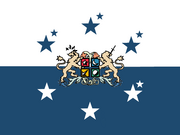
Flag of the AUE Central government
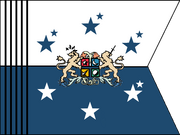
War flag of the Eurasian Federation
The Eurasian Federation is a constitutional nation-state federation. The government's decisions and actions must first be deemed right and allowable by the constitution and be in accordance to it in every way. The government cannot be above the law of the country even if it is the government. The AUE is divided into nation-states each governed by their own local state government, all with equal rights and power, who ultimately adheres to the central government. A state laws passed in a certain nation-state would only have jurisdiction within the said area but central laws passed would be in effect in all of the AUE.
The constitution of the Alliance of United Eurasia states that the government would be split into the central and state with both governments having its own local executive, legislative and the judiciary. The constitution also includes a separation of power between the executive, legislative and judiciary, that is the three branches must work independently and separately from the others. Only the Chairman of the Federation serves as the link between the three and can issue orders to them given that it is within the laws and constitution of the AUE. A referendum may only be held to impeach the Chairman, the President, or the Speaker or to vote for the adoption of a new constitution or to amend it.
Foreign Affairs[]
- Main article: Foreign relations of the Eurasian Federation
The Eurasian Federation is considered a neutral nation having healthy relations with both western and eastern countries. It is currently maintaining no formal diplomatic relations with Russia, Bulgaria, Greece, Syria, Iraq and Iran. While it has tense relations with Turkey and Ukraine although the country is trying to lessen the cautiousness and wariness between them. Romania, Moldova, Kazakhstan, and Uzbekistan are classified as key regional allies. The AUE is also a staunch supporter of India, Argentina and South Africa. The country is pursuing good ties with the post-Soviet states with the exclusion of the Russian Federation. Moscow accuses the AUE of supporting and protecting insurgents in Dagestan and Kabardino-Balkaria.
The AUE is a member of the United Nations, Commonwealth of Independent States, Black Sea Treaty Organization, International Monetary Fund, Eurasian Economic Community and World Trade Organization. It is a partner-nation of NATO and an observer in the Shanghai Cooperation Organisation. The Eurasian Federation is applying to join the Organization for Democracy and Economic Development to extend its ties with Ukraine and Turkey.
The AUE withdrew from the Collective Security Treaty Organization due to conflicting interests and problematic relations with Russia. Due to the same reason also, the country declined to join the Eurasian Union. However, the Eurasian Federation still has good or normal relations with Kazakhstan, Uzbekistan, Kyrgyzstan, Turkmenistan and Tajikstan.
The AUE is currently proposing a new bloc of former Soviet Union states which excludes Russia and Belarus; so far only the Baltic states, Ukraine, and Moldova have expressed their interests.
The Eurasian Federation tries to keep good ties with international organizations and member-states of the European Union, African Union, and Union of South American Nations.
The Eurasian Federation also has formal relations with the Federated Republic of Bowasia, Union of Midway, United States of Pelicania and the United States of JBR. Formal relations have been suspended with the Empire of Antioquia due to the Antioquian-Moroccan War.
The status of diplomatic relations of the AUE to a country is categorized in tiers:
- Tier 0 Gray - no formal relations yet
- Tier 1 Black - severed/suspended relations
- Tier 2 Red - tense relations
- Tier 3 Green - normal relations (with economic and trade cooperation)
- Tier 4 Aqua - friendly/good relations (with foreign assistance and technological/scientific cooperation)
- Tier 5 Blue - excellent relations (with political and military cooperation)
Military[]
- Main article: Joint Military Command of the AUE

Emblem of the Joint Military Command
The Joint Military Command (JMC-AUE) is an official military organization of the Eurasian Federation that traces its roots back to the formation of the Alliance of United Eurasia. Its first ever participation in warfare is the Black Sea War. The commander-in-chief of the JMC-AUE is the Chairman while a Supreme Commander acts as the general chief-of-staff. The Department of Defense, under its Secretary, gives executive orders, sets policies, and regulates the JMC-AUE and other defense-related organizations.
Administrative divisions[]

The Eurasian Federation with its nation-states
Central Government:
 Black - Black Pearl City
Black - Black Pearl City
State Governments:
 Blue - Georgia
Blue - Georgia Yellow - Azerbaijan
Yellow - Azerbaijan Red - Armenia
Red - Armenia Purple - Crimea
Purple - Crimea Light Green - Ossetia
Light Green - Ossetia Light Blue - Chechnya
Light Blue - Chechnya Pink - Nagorno-Karabakh
Pink - Nagorno-Karabakh Brown - Abkhazia
Brown - Abkhazia Orange - Ingushetia
Orange - Ingushetia Green - Nakhchivan
Green - Nakhchivan
Geography[]

|
| |||||
| Caspian sea | ||||||
| Black sea |
The northern portion of the Caucasus is known as the Ciscaucasus while the southern portion is known as the Transcaucasus. The Ciscaucasus contains the larger majority of the Greater Caucasus mountain range. It also includes the southwestern Russian district and northern Eurasian Federation (Ossetia, Chechnya and Ingushetia and the northern parts of the Georgian and Azerbaijan nation-states). The Transcaucasus, on the other hand, is bordered on the north by Russia, on the west by the Black Sea, on the east by the Caspian Sea, on the southwest by Turkey, and on the south by Iran. It includes the Caucasus Mountains and surrounding lowlands. All of the Eurasian Federation nation-states of Armenia, Azerbaijan (excluding the northern parts), Georgia (excluding the northern parts), Abkhazia, Nakhchivan, Nagorno-Karabakh are in the South Caucasus. The main Greater Caucasus range is generally perceived to be the dividing line between Asia and Europe.
The Caucasus is an area of great ecological importance. The region is included in the list of 34 world biodiversity hotspots.It harbors some 6400 species of higher plants, 1600 of which are endemic to the region. Its wildlife includes leopards, brown bears, wolves, bison, marals, golden eagles, and hooded crows. Among invertebrates, some 1000 spider species are recorded in the Caucasus. The region has a high level of endemism and a number of relict animals and plants, the fact reflecting presence of refugial forests, which survived the Ice Age in the Caucasus Mountains. The Caucasus forest refugium is the largest throughout the Western Asian/near Eastern region. The area has multiple representatives of disjunct relict groups of plants with the closest relatives in eastern Asia, southern Europe, and even north America. Over 70 species of forest snails of the region are endemic. Some relict species of vertebrates are Caucasian parsley frog, Caucasian Salamander, Robert's Snow Vole, Caucasian Grouse, and they are almost entirely endemic groups of animals such as lizards of genus Darevskia. In general, species composition of this refugium is quite distinct and differs from that of the other Western Eurasian refugia. The natural landscape is one of mixed forest, with substantial areas of rocky ground above the treeline. The Caucasus Mountains are also noted for a dog breed, the Caucasian Shepherd Dog.
Economy[]
- Main article: Economy of the Eurasian Federation
Due to the diverse nation-states that compose the Alliance of United Eurasia, diverse economic environments have made the AUE economy competitive and relatively independent and self-sustaining. Nation-states which are highly industrial can depend on the others to provide it with raw materials which makes the Eurasian Federation the 12th largest exporter of manufactured and industrial goods like machinery. The Eurasian Federation's economy is self-sustaining in most of its sectors except for fishing due to the condition of the Black sea. The AUE also boasts its vast agricultural sector which makes the country the 19th largest exporter for agriculture (major exports are tea, tobacco, buckwheat, corn and fruits like tangerine, hazelnuts, apples, and grapes).
The GDP grew by 16.3% on 2003 which was the highest GDP growth for the country ever since its formation. Unemployment is very low, only at 0.79% since certain central government policies would have to conscript unemployed adults for more than one year into the military until they get an occupation again. The only major recession that the AUE experienced was during 2006-2007 when the United States collapsed.
Although the AUE heavily imports fish and other seafood, the local fishing industry is slowly being revitalized by the AUE through constant rehabilitation projects initiated to the Black sea but concerns are growing over the move for self-sufficiency since it could effect the international trade of fish. The shipping industry have been revived by the AUE after a costly project to upgrade the Great Dam in the straits of Dardanelles and Bosphorus. The controversial project allowed the passage of large ships through the narrow straits which were enlarged and made into a linear path artificially, a move which was criticized by environmentalists group.
Demographics[]
Population in the Eurasian Federation increased from 2000 to 2010 by approximately 6 million, a 34% growth in that time frame. As of 2011, the AUE has become the world's 56th most populous nation (0.29% of the world's population), with over 19 million citizens. The population growth rate between 1994 to 1999 decreased by an estimate of 6.95%. The population's median age is 28.6 years with 54.9% aged from 18 to 60 years old. Life expectancy at birth is 75.9 years, 77.3 years for females and 72.8 years for males. Population density is at 102.5 per sq. mile.
There are about 500,000 Eurasians outside the country. With communities forming in other European countries, East Asia and Southeast Asia.
The AUE is trying to exponentially raise its population growth by giving incentives and aims an annual 5% increase in population growth per year. The central government deems the current population size too small compared to other countries. The population size was greatly affected by the Black Sea War and by the Eurasian 100 Days of Blood. By 2015, the estimated population size is around 25 million.
People[]
Ethnic groups in the Caucasus region of the Eurasian Federation are Caucasians, Kartvelians, Northeastern, Northwestern, Turkish, and Indo-Europeans.
In a 2010 survey, most of the people in the AUE answered that they are Eurasian with ancestry from Georgia, Ukraine, Armenia, Azerbaijan, Slav, Cossack, and even Russian.
Language[]
The languages of the Caucasus are a large and extremely varied array of languages spoken by more than 20 million people in and around the Caucasus Mountains, which lie between the Black Sea and the Caspian Sea. Linguistic comparison allows these languages to be classified into several language families, with little or no discernible affinity to each other.
Because the Alliance of United Eurasia is composed of nation-states that have different cultures, there are a lot of dialects and languages that are spoken in the country. It is essential to learn at least the official languages (English, Georgian, Ukrainian, Azerbaijani, Armenian, Russian).
Religion[]
Today the people of the Caucasus tend to be either Eastern Orthodox Christians, Oriental Orthodox Christians, or Sunni Muslims. Shia Islam has had many adherents historically in Azerbaijan, located in the eastern part of the region.
Health[]
The Eurasian Federation adopted a health care policy for the implementation of a Universal health care. The central and state governments are funding a public reform in health care and insurance.
Public hospitals and clinics provide patients with free checkups, free hospital admissions, medical and dental treatments including surgeries. Reproductive health, childbirth, pediatrics and family planning are also being provided by the government for free. Public hospitals are considered to be of adequate quality.
Private hospitals on the other hand are reserved for the upper-class and are grand and luxurious and although treatment is expensive, the quality served is top-notch and considered fail-proof.
Most pharmacies are state-owned and provide pharmaceutical drugs and free supplements.
Phage therapy is legally allowed in the country and are being used to complement/supplement antibiotics. The country also boasts that its citizens have a 90%-100% access to potable water and sanitation.
Education[]
Education is mandatory for all children aged 7-18 years old. The school system is divided into elementary (6 years; age level 7-12), high school (4 years; age level 13-16) and tertiary school (2 years; age level 17-18).
Preschool education, normally for 3 years (4-6 years old), is not required but highly encouraged by the government which is provided for free. Higher and vocational schools are optional but also encouraged by the government.
The private sector controls approximately 60% of schools, colleges and universities in the country although all kindergarten schools are owned by the government.
Schools specifically teaching technical and business have grown popular in urban cities along with military and interests schools.
Culture[]

Lead Bells Media, a state-owned major broadcasting company and television network
Public Holidays[]
The following are the public holidays observed throughout the Eurasian Federation in chronological order:
- 1 January - New Year's Day
- 10 February - EuraDay/Eurasia Day
- 21 March - Ghirliando Day
- Variable - Maundy Thursday
- Variable - Good Friday
- 16 April - Memorial Peace day
- 30 June - Naggiar Day
- May 1 - International Workers' Day
- Variable - Eid-ul-Fitr
- 19 September - Union day
- 3 October - Fouzen Day
- Variable - Eid al-Adha
- 10 November - Heroes' Day
- 25 December - Christmas
The following are holidays observed in certain nation-states only in chronological order:
- 6 January - Nagorno-Karabakh Day
- 12 February - Crimea Day
- 9 April - Georgia Day
- 9 June - Black Pearl Day
- 23 August - Armenia Day
- 30 August - Azerbaijan Day
- 20 September - Ossetia Day
- 12 October - Abkhazia Day
- 1 November - Chechnya Day
Symbols[]
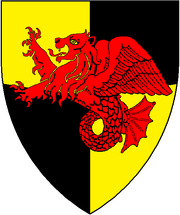
Eurasian Great Lion
The following are considered as symbols representing or associated with the Alliance of United Eurasia:
- Father Virtue or Father Eurasia, an elderly male in full dress representing the Eurasian Federation. Variations:
- An elderly gentleman in a formal business suit (varying: Black tie, White tie, Tuxedo, Tailcoat) with a cane and hat (varying but mostly military/formal hats)
- An elderly commander in a military dress with a military cap and sheathed sword in a scabbard connected to a belt or shoulder sling or both.
- Both depictions may also include a coat (Frock coat or Overcoat), cigars and other accessories.
- Tierra Naggiar, Secretary-General of the Alliance of United Eurasia and 1st Chairman of the AUE
- Richard Ghirlandio, Supreme Allied Commander of the AUE during the Black Sea War
- Ulster Fouzen, reservist who halted insurgency advances during the Eurasian 100 Days of Blood
- Lion, Horse (both national animals)
- Great Lion (a sea-lion with wings), Unicorn
- Black Sea, Caucasus Mountains
- World Pillar



